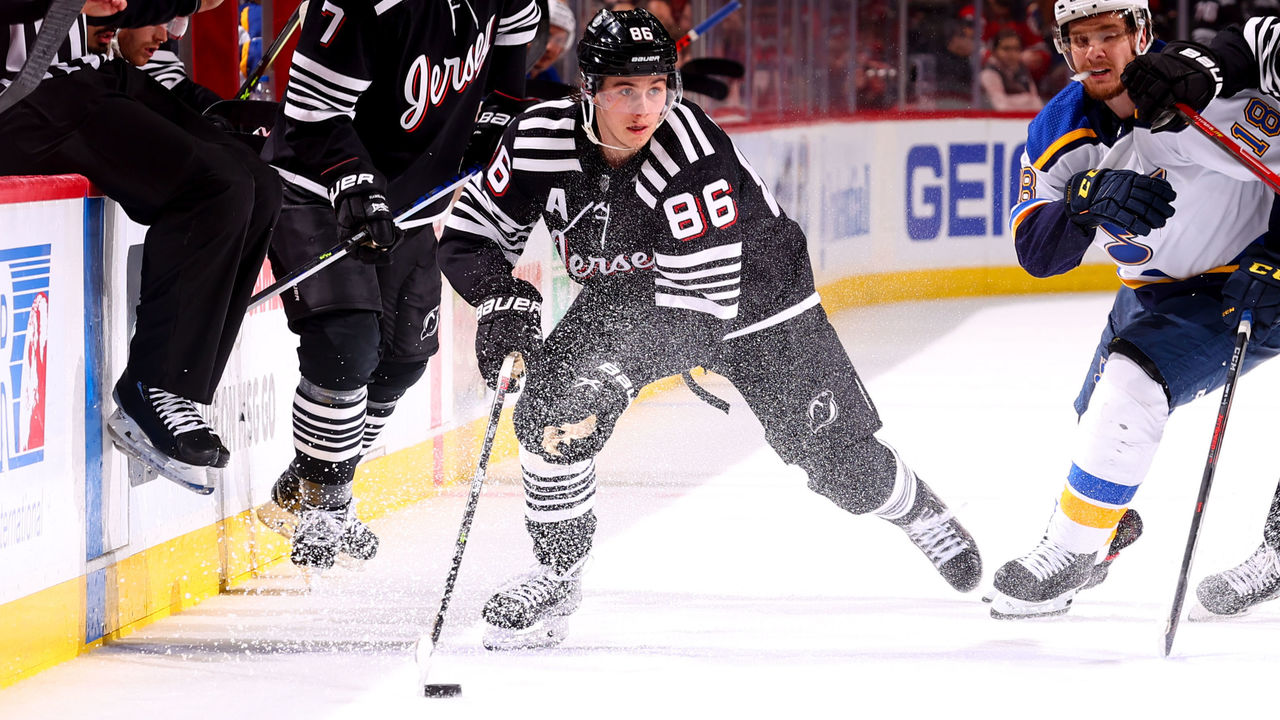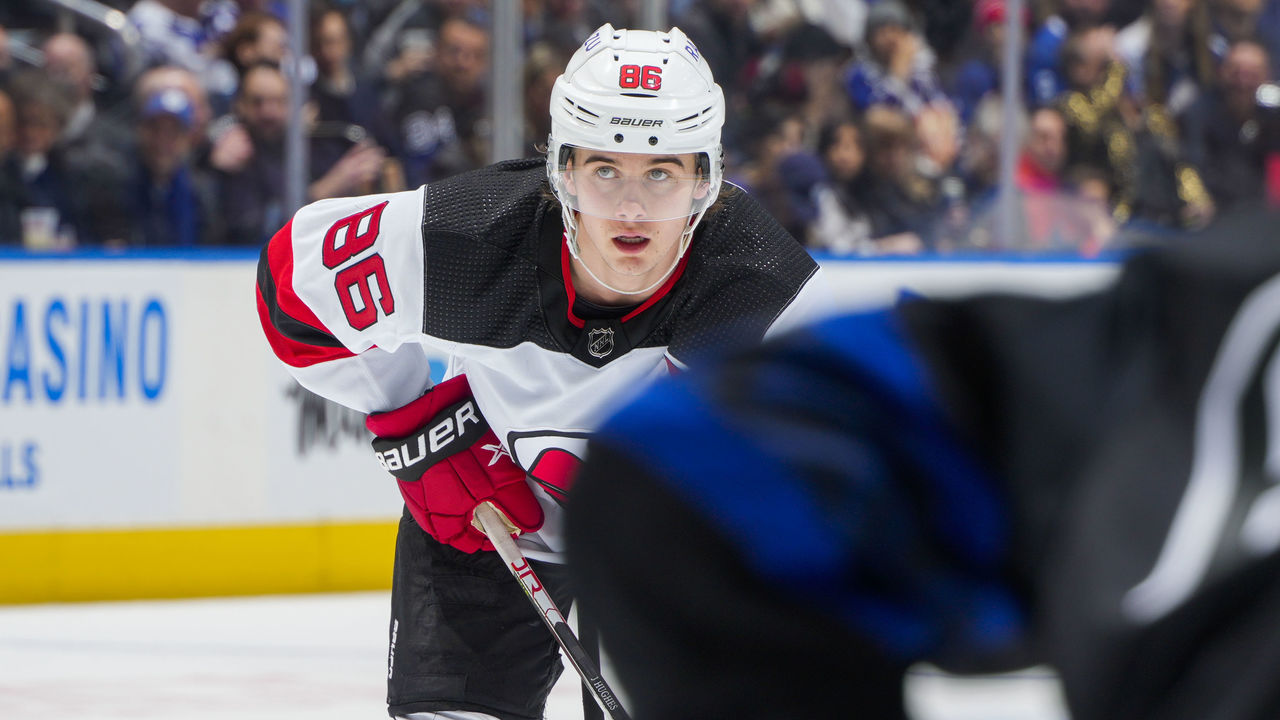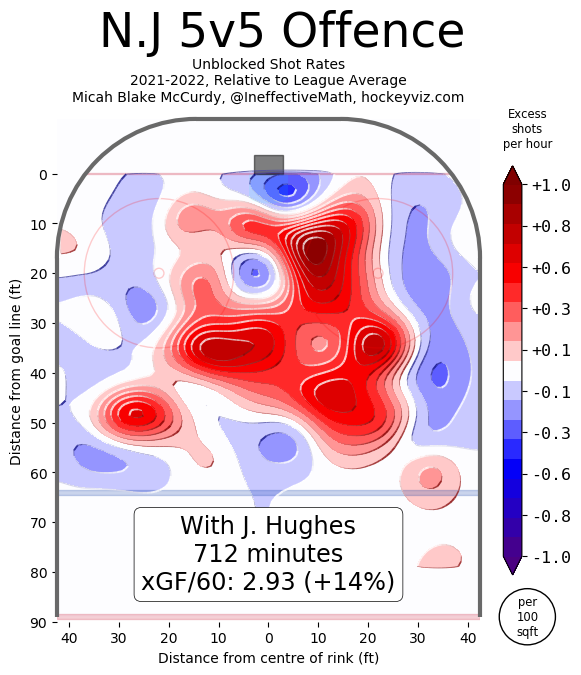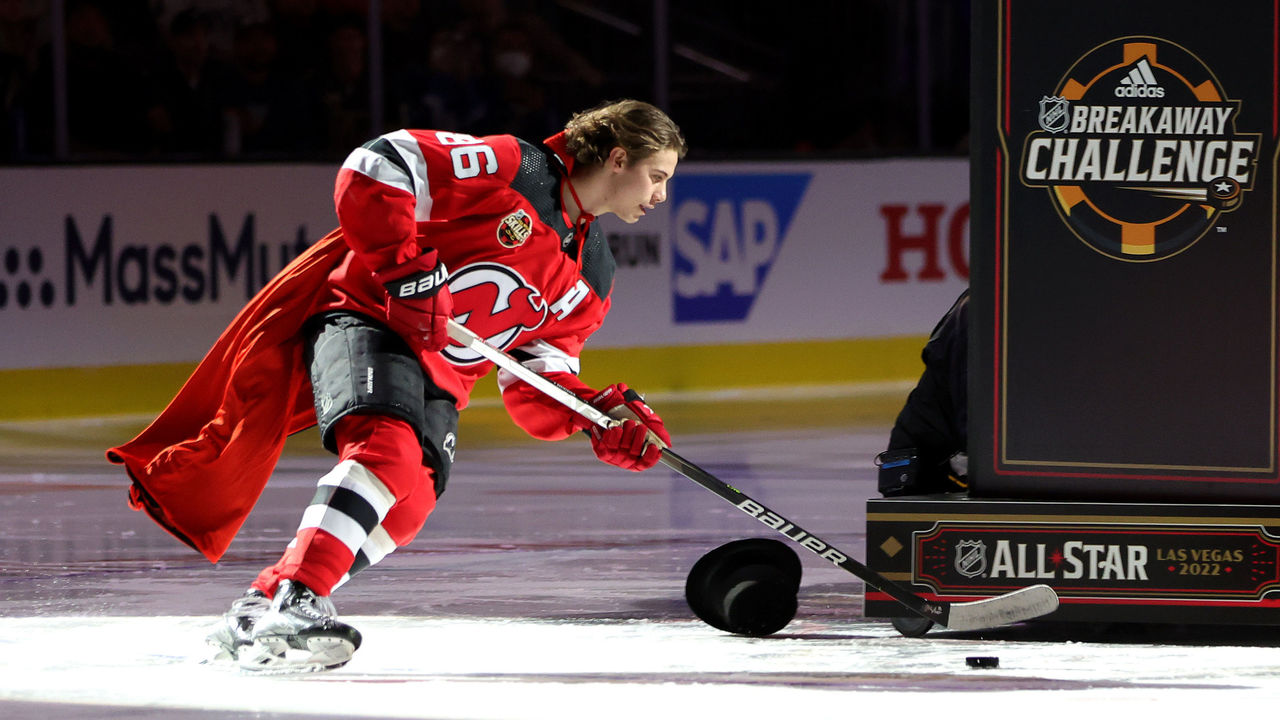New Jersey was down 4-2 with two minutes left in the third period on Saturday when Jack Hughes corralled a pass deep in the Devils' end.
Skating backward, Hughes turned his body 180 degrees in one smooth motion to maintain his speed and keep control of the puck. The Devils had an extra attacker on the ice and the Washington Capitals were sitting back, an ideal scenario for a burner like Hughes.
As he zoomed through the neutral zone, Hughes looked similar to Connor McDavid - the master of skating. Then, as he went inside-out on veteran defenseman Dmitry Orlov and entered the offensive zone, he looked like Patrick Kane - the one-on-one genius.
Hughes ultimately failed to get a shot on goal, his attempt negated by a stick check. Ten seconds later, he slammed his own stick in frustration after a teammate opted to shoot the puck instead of passing to him while he was wide-open.
"He's only 20 years old, and I like that at a young age he's got that kind of bravado," said Ken Daneyko, the longtime Devils defenseman turned TV analyst for MSG Networks.
Daneyko added: "It's not a selfish act. It's him saying, 'When we need a big play, just know where I am. I will get it done.'"

New Jersey eventually scored with the extra attacker and Hughes picked up the primary assist. But that tally was all they could muster in the 4-3 road loss.
Those final two minutes against the Capitals are representative of Hughes' current place in the NHL universe: he's a tantalizing, highly productive, and super-competitive center in his third season playing for a team mired in a lengthy rebuild.
Since Dec. 29, Hughes has accumulated 19 goals and 27 assists for 46 points in 33 games. It's easily the best three months of his career, with a points per game rate of 1.39, which ranks ninth in the league over that stretch. This type of breakout had been a long time coming for the 2019 first overall draft pick.
What should we make of Hughes' rise to stardom? Below, we dive into some statistics and identify areas of his game where he's leveled up.
The statistical profile

Heading into the 2019 draft, scouts peppered reports with the word "elite" as Hughes set a new points record at the U.S. National Team Development Program. He was literally skating circles around junior- and college-level competition; he was can't miss material, the no-brainer pick for first overall.
Fast forward a year and pockets of the hockey community had grown dismissive of the pre-draft hype. Hughes was underwhelming as an NHL rookie - a hotshot kid who looked out of place in all three zones on the ice.
Still only 18 years old, he collected just 21 points in 61 games, a rate of 0.34 points per game. Patrik Stefan, who went first overall in 1999 but failed to live up to lofty expectations, posted 0.35 points per game as a 19-year-old rookie.
The Stefan comparison was an easy reference point for fans and pundits, although perhaps not entirely fair due to the management and personnel turnover in New Jersey. As Hughes told theScore recently: "I was just a young guy figuring it out."
It's safe to say Hughes has managed to reboot the narrative and recalibrate his ceiling. Thursday's Devils-Bruins game will be the 164th of his career - the equivalent of two full seasons - and the second 82-game block has been far more productive. This year, the confident, perhaps even cocky, playmaker-sniper hybrid is on pace for 32 goals and 40 assists in 62 games. (Hughes missed 17 games in the fall due to a dislocated shoulder, and another three in January after being placed in COVID-19 protocol.)
Only 11 players in the salary cap era have finished a season with a point per game or better before turning 21. At a 1.17 rate, Hughes currently ranks sixth, sandwiched between 2016-17 McDavid and 2009-10 Steven Stamkos.
Ty Smith, the young Devils defenseman who shares a New Jersey apartment with Hughes, believes his close friend is "going to be a 100-point guy" one day. Good luck crafting a compelling argument against that, as both the numbers and eye test indicate Hughes is one of the game's transition kings.
In fact, according to Sportlogiq data cited during a recent Devils-Rangers broadcast, nobody in the NHL generates more scoring chances off the rush per game than the fast and audacious Hughes. Nope, not even McDavid.
"He could be one-on-four. Most guys would just dump it in, but he tries to beat them," Smith said. "And he might do it."
The blue-liner added: "Sometimes he gets to a point where it kind of just looks like he's floating on the ice. It's just effortless, and he's flying around."
Focus on Hughes' busy feet here:
Hughes is the Devils' top facilitator at even strength and on the power play, where he helps quarterback the first unit from the right-point position.
This year, Hughes has skated at five-on-five with sharpshooter Yegor Sharangovich and either Jesper Bratt or Dawson Mercer. Hughes, Sharangovich, and Mercer - a rookie - have found their rhythm as a trio, leading to 12 goals for and 12 against despite unstable goaltending behind them.
Generally, when Hughes is on the ice, the Devils win the territorial battle. So far in 2021-22, the club has owned 52.8% of the shot attempts and 54.7% of the expected goals in Hughes' 711 five-on-five minutes, per Evolving Hockey.
As the HockeyViz heatmaps illustrate, Hughes' offensive-zone impact at even strength has intensified over his career. The Devils' offense has generated 14% more expected goals for per 60 minutes than the NHL average when he's on the ice this season, a significant jump over his rookie season.
Hughes' five-on-five minutes in 2019-20

Hughes' five-on-five minutes in 2021-22

Hughes has also excelled at avoiding the penalty box since Day 1 while putting the Devils on the power play fairly often.
As a rookie, Hughes finished with a plus-12 penalty differential (17 minors drawn, five minors taken). Last year, he was plus-16 (19-3). This year, he's making a strong case for the Lady Byng Trophy at a cool plus-15 (15-0).
"I feel like I have way more than 15? Is that it?" Hughes said. "There's nothing really to it. I just put my stick in the right place so I don't take penalties. And the other way, when you have the puck a lot, that's what's going to happen."
Areas of progress
Hughes was listed at 5-foot-10, 170 pounds ahead of the draft. He's now listed at 5-foot-11, 175. Despite growing an inch and (apparently) packing on only five pounds over three years of off-ice training, there's a noticeable difference in how Hughes handles himself along the boards and in the slot.
"He doesn't get pushed around as much as his first year, if at all," Devils assistant coach Alain Nasreddine said. "The thing with Jack is that he's so competitive. He doesn't shy away from the hard areas. He'll go into traffic, go into one-on-one battles, and every time he wants to get the puck back."

That "inner drive," as Daneyko calls it, has helped Hughes elevate his defensive game. To be competent defensively, awareness and timing are key.
"Look, he's not going to win a Selke Trophy because you want him to do what he does best and create offense," Daneyko said. "But he's gotten smarter. In his own zone, he's one of the most effective guys at stealing pucks."
Of course, it always comes back to skating with Hughes.
Dynamic, crossover-heavy skating has been his bread and butter for a decade, and the added muscle has made him an even better skater. Smith, for one, thinks Hughes' already elite skating is "at another level" right now.
It's a hard claim to confirm, but there's enough evidence to suggest Hughes is stronger on his skates, which in turn allows him to maintain a high rate of speed while fighting through stick and body checks.
Below is a sequence that seems innocuous but is actually instructive. Pay attention to how Hughes reacts to the defenseman trying to bump him:
Nick Quinn of Power Edge Pro, a skating and skills company with dozens of NHL clients, has worked with Hughes for seven years. He notes Hughes' ability to "give off false information" - or deceive opponents - has improved.
"That's what's made Jack so effective as he's gotten comfortable in the NHL," Quinn said. "He's not the biggest guy, but he puts defenders in bad positions when he moves pucks into open space and he moves his feet at the same time. Not many players can do that on a regular basis."
Based on the eight-year, $64-million contract extension Hughes inked in November - before he had truly broken out - the Devils weren't fretting the first two-plus seasons of his career. The team was banking on his awful shooting percentage (5.7% and 7.7% in his first two seasons, respectively) normalizing over time. They projected the franchise cornerstone would grow into an all-world passer and shooter. So far, so good in 2021-22 - 24 goals scored on 14.8% shooting.
"It's more accurate. It's got more velocity. He gets it off quicker," Daneyko said of Hughes' shot. Nasreddine believes "the game has slowed down for him - even though he plays at a high pace, extremely high pace."
If the game is slowing down for a burner like Hughes, look out.
John Matisz is theScore's senior NHL writer. Follow John on Twitter (@MatiszJohn) or contact him via email (john.matisz@thescore.com).
Copyright © 2022 Score Media Ventures Inc. All rights reserved. Certain content reproduced under license.